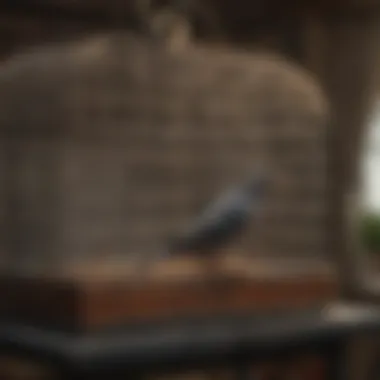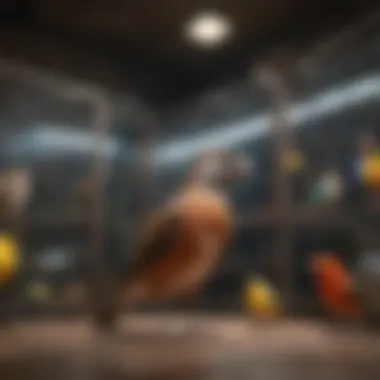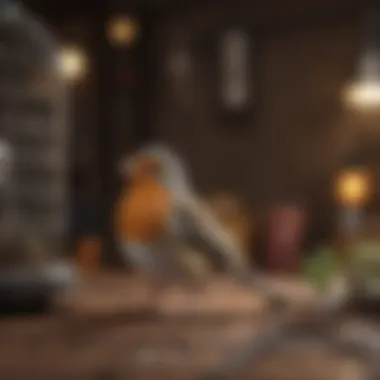Essential Features of Breeder Bird Cages Explained


Intro
Breeding birds requires a structured approach, especially when it comes to creating the right cage environment. This guide will help bird owners and breeders understand the essential features and needs these creatures require. By focusing on adequate care, nutrition, and health considerations, owners can provide supportive habitats that facilitate successful breeding. Underpinning this is a firm recognition of the necessity and responsibility involved in nurturing these animals in their most formative stages.
In general, proper care tips are crucial in ensuring that both parents and chicks thrive. The next sections of the guide will delve into specific care routines, behavioral insights, nutrition guides, wellness, and enriching activities designed to optimize breeding conditions. Understanding the basic needs of these birds will lead to better outcomes—not just for the birds themselves but also for their owners.
With this in mind, let's start with a look at the foundational care that these creatures will need.
Understanding Breeder Bird Cages
Breeder bird cages are fundamental for breeding enthusiasts. They serve a dual purpose: protecting birds while promoting successful breeding. Understanding these cages allows for more informed decisions that align bird welfare with breeding goals. Important aspects, such as size, construction materials, and interior design of the cages play crucial roles in successful breeding endeavors.
Definition and Purpose
A breeder bird cage is crafted specifically for breeding birds. Its design caters to the unique needs of birds during mating and parenting stages. These cages typically offer spacious interiors, allowing birds plenty of room to mate and raise their chicks.
The primary purpose is to foster a conducive environment for breeding. Specialized features, such as sufficient ventilation and separate compartments, reduce stress and enhance the likelihood of successful breeding events. In this context, they provide sanctuary and breeding grounds in a safe, controlled environment that mimics their natural habitat.
Benefits of Breeder Cages
Choosing a dedicated breeder cage can lead to numerous advantages.
- Healthier Breeding Practices: A proper cage allows birds to thrive while pairing and rearing young, significantly improving health outcomes.
- Reduced Stress: Space and appropriate constructs minimize stress on birds, encouraging successful mating.
- Control Over Environment: Breeder cages allow owners to better monitor conditions such as temperature and humidity, crucial factors in egg incubation and chick survival.
- Easy Maintenance: With strategic designs, these cages simplify cleaning and caregiving tasks.
Proper understanding of breeder bird cages can raise breeding success rates significantly. Both the selection of materials and the structure require thoughtful consideration to tailor to specific bird species' needs.
Investing time in selecting the right breeder cages ensures a healthier and more successful breeding environment. These cages play a significant tokie in ensuring health and wellness during these critical stages.
Key Features of Breeder Bird Cages
Understanding the key features of breeder bird cages is essential. It helps individuals make informed decisions about their bird's living conditions. A proper cage includes considerations like size, material, and design elements that significantly impact bird welfare and successful breeding.
Size and Space Considerations
When deciding on a breeder bird cage, size matters greatly. Adequate space allows birds to move freely, encouraging natural behaviors. Larger cages provide room for nesting and flight, crucial during breeding periods. Having sufficient space helps reduce stress. Stress may hinder breeding success and can cause health issues.
A general guideline is to select a cage that offers height as well as width. Many birds, like parrots, enjoy climbing. Measure the cage against the size of the birds. The larger the species, the bigger the cage should be.
Wire vs.
Solid Walls
The choice of materials can impact both the safety and comfort of your birds. Wire cages offer ample ventilation while allowing birds to view their environment. This contributes to mental stimulation. On the other hand, solid wall cages act as a barrier against drafts and unnecessary environmental noise. While wire is commonly used, solid options can also be valuable, especially for sensitive species.
Non-toxic Coatings


Non-toxic coatings are more than a safety preference; they’re essential to bird well-being. Many cages have paint or coatings that might be harmful if pecked. Coatings keep the cage easier to clean and maintain. Choosing cages with non-toxic designs ensures birds remain away from potentially hazardous substances. Always revert to established brands known for using safe materials.
Design Elements
The right design elements in breeder cages can significantly impact the birds’ lifestyle. The layout is vital for enabling breeding and maximizing comfort.
Bar Spacing
Bar spacing in cages should match bird species size. Spacing too wide can lead to escapes or injury. Birds can also get stuck between bars, causing significant distress. The ideal spacing prevents these issues while offering security and comfort.
Consider common sizes. Spacing for larger birds should be about 1.5 inches, while smaller birds may need just half an inch. Proper bar spacing enhances safety and allows birds to engage with their environment.
Multiple Compartments
Multiple compartments can facilitate breeding and nurturing. Different sections allow for individual care of pairs or the separation of young from adult birds. Providing privacy can help reduce stress during breeding. This type of design may also improve acclimatization in timid species.
When birds have the ability to retreat into sections, they can create secure areas that enhance reproductive behaviors. This separation is particularly beneficial for social birds that may need solitude at certain times.
The choice of features gives a breeding experience tailored to meet the needs of both birds and owners, forming the foundation for successful breeding endeavors.
Considering the features discussed, it's clear choosing the correct type of cage goes beyond aesthetics and involved comfort, safety, and overall breeding success.
Selecting the Right Breeder Cage
Choosing the right breeder bird cage is paramount not only for the well-being of the birds but also for the success of breeding attempts. Each species of bird has specific requirements regarding space, environment, and comfort that must be met to ensure a healthy breeding process. The subsequent sections will delve into the unique needs of different bird species and the financial implications of those choices.
Species-Specific Needs
Bird breeding is far from a one-size-fits-all endeavor. Understanding the specific habitat needs for each type of bird will profoundly impact both their quality of life and breeding success.
Parrots
Parrots are exquisite creatures known for their vibrant colors and engaging personalities. They require spacious cages with plenty of room for climbing and playing. Unlike other small birds, parrots often enjoy interacting with their environment rather than simply sitting quietly. A significant disadvantage is that their chatter can become quite loud, which might not suit all environments. Therefore, their cages should ideally reach a minimum size, often requiring at least 3 feet in height, with horizontal bars to facilitate climbing. The durability of the cage material must also be considered since parrots are notorious for being beak-chewers.
Canaries
Canaries are increasingly popular for their beautiful songs and relatively simpler care requirements. The ideal breeder cage for a Canary should be long rather than tall, as this species tends to prefer horizontal space over vertical climbing. The bars spaced ½ inch apart work well to ensure canaries cannot escape or injure themselves. Additionally, he is beneficial for their vigilant nature. A disadvantage exists in terms of their solitary tendencies, which means that breeding setups must cater to individual pairs rather than multiple birds.
Finches
Finches are social animals and thrive in groups. They require sufficiently large cages, ideally with multiple compartments to separate breeding pairs when necessary. Their extremely playful nature and tendency to dart around require high ceilings and ample horizontal room. An unique predicament for finch breeding is the difficulty in pairing up compatible mates, which requires time and careful observation. Their ideal cage setup can easily become chaotic if proper precautions are not in place. The choice of food and understanding the finch diet also keys in on their wellbeing during breeding periods.
Budget Considerations
Budget considerations significantly shape the decision-making process for potential breeders. Investing in a high-quality cage tailored to specific needs often pays off in the long run. Prices can vary considerably based on materials, size, and brand. For a practical understanding of where to allocate funds, consider the following key points:
- Initial Costs: This includes the price of the cage along with a selected dietary plan for the species.
- Long-term Maintenance: Quality cages may require less frequent replacement, benefiting breeders in the longer term for the stability in their birds’ living situations.
- Accessories: Different cages may require unique accessories such as food and water containers, enriching items like swings, and more.


In summary, the process of selecting the right breeder bird cage necessitates a deep understanding of the specific needs of different species. When coupled with careful budget considerations, pet bird owners can secure a setup that best supports the health and wellbeing of their feathered friends. Meeting these guidelines leads naturally into the correct environment for breeding, ultimately serving both birds and breeders alike.
Setting Up the Breeder Bird Cage
Setting up a breeder bird cage is not merely about arranging accessories within a defined space. It plays a critical role in not just breeding success but also in the overall well-being of the birds. Thus, getting it right from the start saves time and ensures that the birds are comfortable. Several elements must be considered in this phase, including cage placement, the introduction of essential accessories, and the intricacies involved in fostering an optimal environment for breeding. Understanding these factors is vital for any potential bird breeder concerned about providing the best for their avian companions.
Cage Placement
Cage placement is foundational. Selecting the right environment can affect temperature, lighting, and general safety. It's best to avoid locations where direct sunlight can create excessively high temperatures. Close proximity to drafts or severe temperature swings can also lead to distress for the birds.
Moreover, access to natural light is important, but it should come with limitations. The light intensity should not be overpowering. A well-illuminated area can aid in both psychological well-being and natural rhythms. Ideally, placing it away from psychical disturbances, like heavy traffic within the home, can help prevent stress in breeding birds.
● Plan for at least some distance from overly busy rooms that might contribute to noise.
● Consider choosing high ground. Birds often prefer to be up high where they feel secure.
● Look for spots that enable visibility. You will want to monitor them easily to ensure their health and comfort at all times.
Accessories and Enrichment
Introducing appropriate accessories and enhancements to the cage vastly contributes not only to comfort but also to the behavioral health of the birds. Each element serves to not only fulfill their immediate needs but also their psychological understandings of the space around them.
Perches
Perches represent one of the most significant components inside a breeding cage. A variety of perches is advisable to encourage natural behaviors. Natural wood perches provide varying thickness. This is relevant because the shapes benefit a bird's grip and foot health. Well-positioned perches engage them physically, and cognitively while providing a space for resting and sleeping.
Key Characteristic: Variety in perch height and structure
This creates both comfort zones and challenges.
Unique Feature: Tips of perches can be rough, which is essential as it aids in keeping nails from getting too long; a major benefit for ensuring your bird's well-being.
Nest Boxes
Nest boxes have crucial importance when setting up a breeding environment. These boxes encourage breeding behaviors in pairs and provde an intimate space for laying eggs. They can be housed within the enclosure and still ensure their accessibility for both birds and the caretaker. Checking them frequently for maintenance is also simplified.
Key Characteristic: The space inside
The space needs to be just the right size; large enough for the bird to turn easily, but compact enough so the birds feel secure,
Unique Feature: You can buy nest boxes with materials that are easy to clean. It is an essential trait that prospective breeders often seek.
Food and Water Supplies
Proper food and water supplies are indispensable within the breeding environment. Adequate and routine supplies of nutritious combinations directly supports the breeding process and nurtures the health of hatchlings. Making sure that feeders and water sources are separate will also help secure quality, as accidents can happen.
Key Characteristic: Accessibility is key
It needs to be at an appropriate height and easy for the birds to use calmly.
Unique Feature: Rotating sizes can help reduce waste in food suces deliveries. Ensuring minimal contact with bedding since supplies left directly on substrate can cause contaminants which lead to illness.
In summary, carefully setting up a breeder bird cage prepared these birds not just in terms of functionality but it also mentally stimulates them. Addressing the specifics about cage placement and addressing essential enrichments will create the best possible outcome. Such provisions crucially address species requirements, encourages rehabilation, stress relief, and overall healthy development.
Maintaining a Healthy Breeder Bird Environment
Ensuring a healthy environment for breeding birds is critical for their well-being. A proper setup contributes to the overall success of the breeding process, impacting both the health of the adult birds and their offspring. A clean, stimulating, and secure environment aides in reducing stress and enhances breeding success.


Cleaning Protocols
Regular cleaning of the cage and its surroundings is of utmost importance in maintaining a healthy breeding environment. Birds excrete waste that can harbor bacteria and parasites. Allowing waste to accumulate can lead to respiratory issues and infections. Here are essential cleaning practices to follow:
- Daily Routine: Spot clean any droppings or uneaten food every day. This precaution helps to spot potential health issues early.
- Weekly Cleaning: Remove all accessories and clean them with non-toxic soap and water. Rinse well to eliminate any chemical residues.
- Monthly Deep Clean: Empty the cage completely and scrub all surfaces with a safe disinfectant. Ensure everything is dry before setting up again.
- Disinfect regularly using a bird-safe disinfectant. Be mindful of areas that may gather mildew and alter humidity levels within the cage.
- Change Bedding frequently to maintain hygiene levels, particularly in nest boxes.
A cleaner cage promotes a more positive home for your birds. It minimizes the risk of transitioning infections, giving parents the best chance to rear their young successfully.
Health Monitoring
Routine health monitoring of breeder birds is as essential as maintaining cage cleanliness. Keeping an eye on their physical and behavioral changes can lead to the early detection of health problems. To ensure your birds remain healthy, consider the following:
- Daily Observations: Check for changes in weight, appetite, and overall energy levels. Take notes if behavioral changes occur unexpectedly, which can signal diarrhea or signs of distress.
- Regular Veterinary Check-Ups: Schedule annual health evaluations with an avian veterinarian. They can assess feathers, skin, and beaks thoroughly and recommend vaccinations or treatments if necessary.
- Temperature and Humidity Levels: Maintain stability in climatic conditions as drastic changes can lead to stress. Utilize a thermometer and a hygrometer to monitor these factors, comparing them against optimal ranges.
- Monitor Pair Behavior: Observe interactions during pairing and nesting. Aggressive behavior can lead to injuries and potentials stress levels. Separating individuals if aggression becomes a concern is essential.
- Educate Yourself: Stay informed on common avian illnesses specific to your bird breed. Resources such as Wikipedia, or Britannica are useful for this purpose.
By prioritizing regular monitoring of health statuses, alterations can be detected early and treated promptly. A diligent approach not only assures your birds thrive but also guarantees healthy fledgling when the time arrives to raise the young.
In summation, fostering a healthy breeding environment is not just a responsibility but a necessity. The diligence shown in maintaining cleanliness and monitoring health can lead to greater success in breeding endeavors.
Regulations and Ethical Considerations
Regulations and ethical considerations are crucial for creating a responsible and sustainable environment for breeding birds. As a bird owner or breeder, it is vital to understand the legal landscape surrounding avian care. Regular inspections and compliance with health standards can safeguard your family of birds from avoidable suffering. This section delves deeply into the laws and ethical practices that govern breeding, highlighting their importance for bird welfare and promoting responsible ownership.
Understanding Local Laws
Local laws on breeding birds vary widely based on the region. These regulations often cover permits, licensing, and specific guidelines to ensure safe breeding practices. For instance:
- Some areas may require permits to breed certain species of birds.
- Licensing might mandate various health checks to ensure parental birds are disease-free before breeding.
- There could be restrictions on breeding mammals or birds that are considered protected or endangered species.
Failing to comply with local regulations can lead to significant fines or confiscation of animals. It is prudent for prospective breeders to check their local legislation. Visit resources like Wikipedia or Britannica for reliable law reference.
Understanding local laws is not just about avoiding legal trouble, it establishes a higher standard for the treatment of our birds.
Commitment to Animal Welfare
Animal welfare should be at the forefront of all breeding practices. This commitment impacts over the quality of life that birds receive both socially and physically. Important factors include:
- Creating an enriching environment tailored to the birds' needs, considering their species-specific requirements especially for social interactions.
- Maintaining clean and safe living conditions to prevent spread of illness and ensure general wellbeing.
- Adhering to ethical breeding practices to eliminate potential overpopulation or irresponsible breeding habits.
Ethically breeding birds not only uplifts your own practice but also promotes better bird care globally. Joining forums on platforms such as Reddit can provide further collective insights about maintaining welfare standards in the breeding community.
An ethical approach towards breeding can thus create sustainable. It promotes respect towards these living beings who depend on us for their care.
The End and Final Thoughts
Understanding the sphere of breeding birds surpasses mere enjoyment or aesthetic pleasure; it shoulders the weight of responsibility and informed decision-making. A breeder bird cage serves as the fulcrum of this undertaking, significantly impacting both the health and wellbeing of your feathered companions. The points discussed get even more relevant as you look back through the guide. With the right setup, you not only provide a safe haven for your birds but also facilitate their breeding in a manner that promotes their natural behaviors.
Reflection on Bird Breeding Practices
Bird breeding is not just an instinct but also a practice laden with considerable ethical responsibility and intentionality. Comprehending the actual necessities of the species you decide to breed will lead you in a being successful. As you reflect, here are several critical considerations:
- Species Requirements: Different bird species come with unique traits and needs. Understanding these helps in providing adequate support for their breeding and raising young ones.
- Environmental Settings: The significance of an optimally-designed breeder cage cannot be understated. Space, airflow, and enrichment play vital roles in nurturing healthy birds.
- Regular Maintenance: Contributors to the health include adherence to a regime of cleanliness, as sanitation within the cage environment helps forestall disease. Regular checks can ensure any signs of illness or distress are addressed promptly.
"A curated breeding environment shapes not only the physical wellness of birds but influences their interaction with one another."















